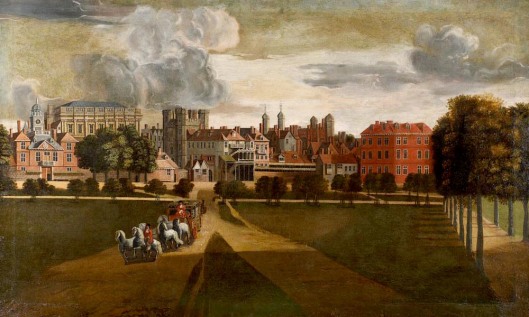In my 2020 A to Z blog challenge each letter links a bit of my family history to a London place-name. The connection is sometimes rather tenuous, so I’m pleased to say that I’ve got a fairly direct link to a well-known ‘W’: Whitehall, the district of the City of London that comprises the administrative centre of the government of the United Kingdom.

The Old Palace of Whitehall by Hendrick Danckerts, c. 1675. The view is from the west, in St. James’s Park. The Horse Guards barracks are on the extreme left, with the taller Banqueting House behind it. Retrieved from Wikimedia Commons.
On 18 December 1768 my fifth great grandfather Edmund Dana (1739 – 1823) was ordained first as a deacon then, a few months later, as a priest of the Church of England at the Chapel Royal of the Palace of Whitehall.

The Reverend Edmund Dana (1739-1823), a miniature in the possession of my father.
The function of the Chapel Royal was (and is) to serve ‘the spiritual needs’ of the reigning monarch and the Royal Family. In practice this meant conducting private religious services for the sovereign. Attached to the Chapel Royal was a choir; the liturgy was often choral.
Administrative structures have a momentum of their own, and by Edmund Dana’s time the Chapel Royal’s role had expanded to include ordinations of well-connected candidates for ecclesiastical office.
It seems likely that self-interest and the ambitions of his wife’s family rather than a sudden rush of religious fervour brought about Edmund Dana’s interest in the Church. He had commenced studying medicine, but when in Edinburgh in 1765 he married Helen Kinnaird, her family, specifically her maternal uncle William [Johnstone] Pulteney
(1729 – 1805), sponsored Edmund Dana’s change of career and supplemented the Dana family income to ease the transition. (His qualification for the role was an MA from Harvard College. It seems likely he received training for the Church of England in London.) Three days after his ordination Edmund Dana was appointed as vicar of Stanion Chapel, at Brigstock in Northamptonshire.

This painting by an unknown artist records the magnificent flotilla of barges that sailed to Westminster to commemorate Sir Henry Tulse being sworn in as Lord Mayor of London on 29 October 1683. In the background is the sprawling palace of Whitehall. The Palace of Westminster is on the left and the roof of the Banqueting House can be seen on the right. Retrieved from The Royal Collection Trust.
Following a fire in 1698 which destroyed most of Whitehall Palace, Sir Christopher Wren was instructed to fit out the Banqueting House, the only part of the Palace that survived the fire, as a Chapel Royal to replace the ruined Tudor chapel. It remained in use as a chapel until 1890.

“Whitehall-Chapel” in Pyne, W. H. ; Combe, William; Ackermann, Rudolph; Rowlandson, Thomas; Pugin, Augustus, The Microcosm of London or London in Miniature, Volume III, London: Methuen and Company, (1904) [1810] . Pages 237 – 239 including Plate 95

The Banqueting House, marked with a black x, was the only part of the Palace of Whitehall that survived the 1698 fire. It is 1/3 of a mile north of the Palace of Westminster.
Sources
- Details of Edmund Dana’s ordination and career in the Church of England are provided by The Clergy Database at jsp/ persons/10426
- ‘Whitehall Palace: Buildings’, in Survey of London: Volume 13, St Margaret, Westminster, Part II: Whitehall I, ed. Montagu H Cox and Philip Norman (London, 1930), pp. 41-115. British History Online http://www.british-history.ac.uk/survey-london/vol13/pt2/pp41-115






